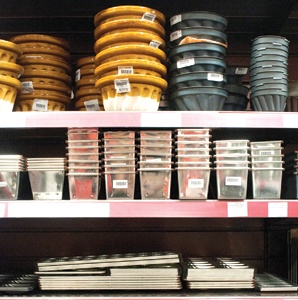
When it comes to colorful markets, cooking tools, and esoteric ingredients, these kitchen essentials shops lead the way.
Every weekend, some of the best food artisans in Britain assemble under railway viaducts in southeast London to display their wares at Borough Market. Amid the profusion of pork pies, puddings, and chutneys, you’ll find the Golden Company (8 Southwark St.; 44-20/7407-1002), whose cold-pressed honeys are a favorite of chef Marcus Wareing of the Berkeley Hotel (who uses them in his ganache-filled chocolates). Part urban beekeeper cooperative, part award-winning social enterprise, the group builds hives around London and trains inner-city kids to harvest and sell their goods. Products include beeswax lip balms and salt scrubs as well as a pollen-rich honey with an herbal top note.
Bring It Back: Pick out a beautiful honeycomb ($10) to pair with fruit and cheese.
If you were in the market for liquid nitrogen or an immersion circulator, Le Sanctuaire (315 Sutter St.; 415/986-4216; by appointment only), which caters to kitchen scientists, would already be on your speed dial. The loftlike showroom may be stocked with gleaming tools of the molecular trade, but chef Daniel Patterson of Coi shops here for more earthy treasures such as Sumatran Sichuan pepper. “Their real specialty is exotic spices—pickled nutmeg; whole mace blade; Javanese luwak coffee,” he says. They’re packaged in eye-catching jars whose design reflects owner Jing Tio’s ultramodern aesthetic.
Bring It Back: Pungent black cubeb peppercorns ($24 per pound), which are hand-harvested on Tio’s farms in Indonesia. The versatile spice is a favorite at San Francisco ice cream parlor Humphry Slocombe, where one of the signature flavors is salt and pepper.
While chefs flock to the storied E. Dehillerin, insiders know that Mora (pictured; 13 Rue Montmartre, First Arr.; 33-1/45-08-19-24) is the destination of choice for makers of haute patisserie. It’s especially popular with the top chefs at the city’s palace hotels, including Camille Lesecq of Le Meurice and Lucien Gautier at the Four Seasons Hotel George V. The selection of baking sheets, crêpe pans, rolling pins, and whisks is unparalleled, but there are quirkier treasures ripe for discovery. Want to make bonbons shaped like the Eiffel Tower? Follow cult chocolatier Jean-Paul Hevin’s lead and head here for the best selection of candy molds in town.
Bring It Back: The fourchette à tremper, or three-tine dipping fork ($16)—used to lower fruit into molten chocolate—is the perfect starter tool for amateur confectioners (or fans of fondue).
Tucked into a strip mall near the airport lies an unassuming storefront that has become a destination for epicurean high rollers. Artisanal Foods (2275 E. Sunset Rd.; 702/436-4252) is the brainchild of Brett Ottolenghi, who made his name as an importer of rare truffles while still in boarding school. More than a decade later, he procures obscure ingredients for the most in-demand restaurants on the Strip and also sells them at wholesale prices in his grocery. Among the luxury items lining the shelves: argan oil, Korean black garlic, and edible gold, not to mention lobes of foie gras, bien sûr.
Bring It Back: Sliced-to-order ibérico de bellota ham (from $912 for a whole leg).
Preservation-minded chefs often partner with local farmers to source hard-to-find heirloom varieties. For Sean Brock of Charleston’s Husk, that partner is Greg Johnsman, who produces stone-ground grits at Geechie Boy Market & Mill (2995 Hwy. 174, Edisto; 843/209-5220). Located on one of the Sea Islands, the picturesque shack provides a lesson in heritage farming. “Grinding corn through a mill that dates from 1945 is like stepping back in time, and Greg’s farm keeps our kitchen full of interesting things, like okra flowers and white peaches,” Brock says. “He’s the next generation of hope for Southern agriculture.”
Bring It Back: Regional staples such as boiled peanuts ($3.50 per pound) and bags of powder-fine white cornmeal ($3 per bag).
A stroll through the Central de Abastos, the city’s oldest open-air market, is like a journey through the encyclopedic contributions that Mexico—and, more specifically, food-obsessed Oaxaca—has made to the global pantry. Vendors hawk dried chiles, rope cheeses, and the seven varieties of mole for which the region is known. On Saturdays, villagers from outlying towns cook up lamb barbacoa and tray-size tortillas at informal stands. Chef Alex Stupak of New York City’s Empellón Cocina loves getting lost amid the bounty. “Try to find a stall that sells tejate, an amazing cold drink made with white cacao and mamey sapote seeds,” he suggests. Also on his list: sal de gusano, a powdered mixture of salt, chiles, and roasted gusano worm, typically served on orange slices as a mescal chaser.
Bring It Back: A molcajete and tejolote, or stone mortar and pestle ($8), is the ultimate souvenir.